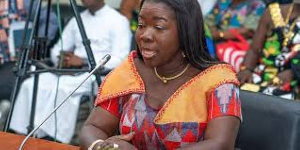By Solomon Mensah& Amankwa A. Felix
You might have your reasons why Black Raster’s Barrack Hussein Obama may never appear in your good books. But as it is said, the duiker’s swiftness must be appreciated even if it is one’s arch enemy.
Obama’s “Yes we can” indeed won him popularity among many. It has lifted the spirit of the downhearted and has inspired great change in the mind-set of multitudes, I suppose. Therefore giving him a thumbs up for it will not cost you a thing.
It is such ‘I can do spirit’ that sent us to Agbozume, Volta Region. Our mission? To find out the secret behind the Ayigbe biscuit, your favourite snack. If you have never come across it, ask your Rapperholic, Sarkodie what it is. It is his favourite.
The state of Agbozume
Here at Agbozume, the town looks beautiful. It has the best of roads as compared to the stretch of manhole-like road between Suhum and Nsawam. On the shoulders of the main road, passing through the town, are nucleated buildings interspersed with kiosks.
Its transportation system is that which allows commuters to have easy access to movement. Although “Okada” is not legalised in Ghana, it ‘floods’ Agbozume like the Bagri Dam’s spillage. As we walked through the town, both smooth and hoarse voices called on us to patronise the service. Ironically, but dead-headedly, we responded to the Okada riders’ call with the only vocabulary we have learnt in the Ewe language, “yoo,” which means “yes.” It took the intervention of our interpreter to clarify the confusion between us and the riders.
The occupation of the inhabitants of Agbozume
At the site of the coconut raffia fencing most of their houses, we had grown thinner than an orphan fed grudgingly by a foster-mother. It had pricked us of the much talked about voodoo of the Ewes. But after a short enquiry, we got to know the bad perception people associate the Ewes with is just a cheap talk. The raffia fencing, as a matter of fact, serves as an enclosure for the women involved in the production of the Ayigbe biscuit. Whereas Koforidua prides herself of B-Foster Bread, the inhabitants of Agbozume and perhaps, the Volta Region, “swag” with the ‘starch biscuit’ popularly called ‘Ayigbe biscuit.’ The name is probably due to the fact that the biscuit emanates from the Ewe (Ayigbe) land.
The manufacturing of the starch biscuit is one of the main occupations of the “Abogzumenians.” If a spade will be called a spade but not a big spoon, it could be said that every household of Agbozume manufactures the starch biscuit. Moving to and fro like an army of ants, the inhabitants of Agbozume, especially the women, work assiduously like the clock daily. Their seriousness towards their work is targeted to ensuring a constant flow in supply of their products to their retailers and wholesalers. History behind the Ayigbe biscuit It is a common knowledge that Tetteh Quashe is credited and hailed across the length and breadth of the country for bringing cocoa from the Fernando Po to Ghana. Moreover, Obunumankoma, Adapagyan and Osono may be worshipped by the Fantes for leading them from Techiman to their present day settlement. But for the people of Agbozume, Madam Yonunawo Kwami Edze will forever be adored for providing for their livelihood.
Clad in a pink gown, Madam Victoria Adzo Adawu, a daughter of Monica Nortoenyeku (the woman who first learned the making of the biscuit from Edze) told the story behind the biscuit.
Before she began telling us the Edze story, she rushed to her room excusing us of being with us soon. On her return, she held a well-kept T-shirt like a terminal results card in the hand of a pupil. The shirt had the name and the picture of Edze with the inscription “Introduced bakery to Agbozume.” The essence of Madam Victoria showing us the shirt was to corroborate the story she was about to tell us.
She said in 1907, Edze returned from Cote D’Iviore with the knowledge of manufacturing the starch biscuit to Agbozume. “She could not have brought anything better than the knowledge in the manufacturing of the biscuit.Now we the descendants are benefiting from its fruit as it employs hundreds of us,” she added. “My mother first learned the bakery as a trade under the tutelage of Edze. She (my mother) then taught other apprentices from near and far. Now the business of the starch biscuit is common with us like the annual ritual in Ghana, the cholera,” she said.
Madam Victoria said plans are far advanced to set a day aside in honour of Edze for her selfless effort towards the development of Agbozume. “A nation or a town that does not honour its heroes is not wealth dying for,” she said while mixing the ingredients of making the biscuit with the cassava starch, “Edze, to us, is a hereon and she must be celebrated and honoured. Since her death in 1963, memories of her have been on our minds like a fresh palm wine.”
The Ayigbe biscuit
Madam Lydia Mensah, a baker, described the biscuit. “It is simply made of cassava starch, coconut, sugar, salt and water.”She said aside the ingredients, one needs equipment such as baking sheets and oven (ekpo in Ewe). “The Ayigbe biscuit ‘perfumed’ of these ingredients used for baking, distinguishes it from the cream crackers and the digestives,” she added. The baking of the biscuit goes through a similar process of baking bread. But unlike bread baking, the Ayigbe biscuit mixes a milled coconut dour with the mixture of the cassava starch and the other ingredients for a good taste. The biscuit is brown in colour with a unique design on one of its sides. The design made with a special stamp (laku in Ewe) brands the biscuit of one producer from the rest on the market.
Although it comes with no branded package, it advertises itself in the white and transparent rubber in which it is packed for sale. If you care to know whether a package of the biscuit can replace your bowl of banku, just chance on one. A package of the Ayigbe biscuit has a well arranged twenty four pieces of the biscuit.
Madam Lydia said a package cost GH?2. As cheap as it is, I guess you will take your “swag” to the next level by grabbing a chilled bottle of the Coca Cola or Alvaro with it.
In a day, a house in Agbozume that manufactures the Ayigbe biscuit sells not less GH?200. With the little effort of not remaining adamant in life, the Abogzumenians are really fending for themselves of the biscuit’s proceeds.
Yes we can
The success story of Agbozume’s Ayigbe biscuit may be as short as a lady’s skirt, but, this skirt is long enough to cover this lady’s essentials. With determination, perseverance and the zeal to succeed, Edze’s introduction of bakery to Agbozume has been given a new breath since 1907. Yes we can. “The Ayigbe biscuit,” Madam Lydia said, “has become a delicacy in and across the shores of Ghana.” If we will believe that our little effort as a nation will push us forward, we can turn our impossibilities to possibilities. The Ayigbe biscuit, for instance, needs a push to as well compete with the cream crackers and the digestives.
Whereas the government is called upon to rethink of helping support the initiatives of our local folks, individuals and stakeholders must also come in. These agencies should take it upon themselves to donating and supporting initiatives that have the potential of raising the bar of our economy. The Ayigbe biscuit aside the people employed in the manufacturing process, it offers employment to retailers in and around Agbozume.
Helen Keller, the leader of the blind, says “life is a daring adventure or nothing.” In daring in life, we must keep behind our ‘coconut’ that for the success story of the Ayigbe biscuit, we can do more than we have ever thought. Long live the Ayigbe biscuit, long live the can do spirit within.
The writers are student-journalists at the Ghana Institute of Journalism Email: nehusthan4@yahoo.com
Opinions of Monday, 11 June 2012
Columnist: Mensah & Amankwa














